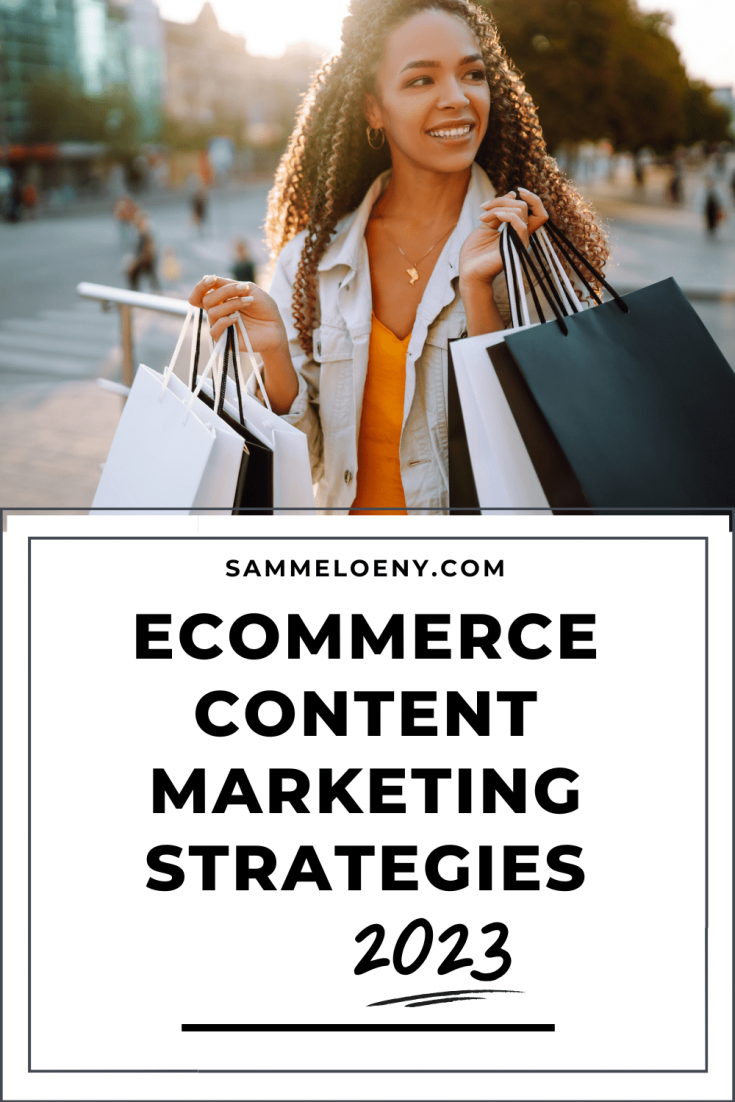In today’s ever-evolving digital world, content marketing for eCommerce businesses is becoming more important than ever before. As a result, traditional strategies of product pages, packaging, and store displays are no longer enough to reach potential customers and keep them engaged. To stay ahead of the competition in 2023, businesses must strategize by incorporating innovative eCommerce marketing strategies that boost visibility and lead to increased conversions. Through platforms such as blogs, press releases, and social media, businesses can develop an engaging library of content that creates excitement for current customers as well as cultivates new interest from potential prospects.
The success of any eCommerce website in 2023 is intimately entwined with the content marketing strategy that it adopts. To be successful, such a strategy will require effective planning and execution.
What Is Ecommerce Content Marketing?
Ecommerce content marketing is a set of marketing practices that focus on creating and distributing content to help customers make informed decisions when shopping online. These materials usually include blogs, videos, webinars, and more. Content marketing empowers advertisers to target their audiences with relevant and actionable information that will help them understand the brand’s offerings, which results in higher quality leads and customer purchases that demonstrate greater value for both the company and the customer. E-commerce content marketing can go a long way toward driving sales and improving overall customer experience by reaching the right people at the right time.
Why Is Ecommerce Content Marketing Important?
For businesses who want to reap the rewards of success online, content marketing should be an essential part of their eCommerce strategy. Creating content not only helps you engage with customers but also informs and guides them from shopping cart to purchase. In addition, content marketing can provide readers with helpful advice on which products will best serve their needs and help foster a trusting relationship between customer and business. Furthermore, content marketing is an effective way to spread your brand’s message, increase web traffic, and boost search engine results, helping your business remain competitive in an ever-evolving digital landscape.
Ecommerce Content Marketing Strategies
Strategy #1: Visually Appealing Content
It’s essential to have visually appealing content in eCommerce. Consumers today respond strongly to well-designed visuals, so it’s important to make sure your photos and videos are professional, polished, and attention-grabbing. In addition, users want to see lifestyle images that evoke emotions and more closely match their needs. When selecting images for your website or product page, think beyond basic product shots and choose something that conveys the feeling of your brand identity. Adding color filters or experimenting with different angles on a single image can help you bring your message across in new and creative ways.
Strategy #2: Find the right marketing channel for your business
Leveraging social media channels is a great way to maximize eCommerce visibility.
With thoughtful market analysis and continuously evolving content strategies across different social networks, you’ll be able to capture and build a larger digital customer base around your eCommerce business.
Some social media channels to try:
Blogs
Blog posts can be a great way for eCommerce brands to build trust and credibility with consumers. Providing people with useful, relevant content can help them establish a connection and become known as an expert in the industry. Blogging also allows eCommerce brands to reach out to new customers by reaching people who might not have previously visited their website or social media channels. It can also engage customers in conversations about their product offerings, promotions, and offers. Additionally, blogging provides an effective SEO technique that can attract more people to websites when they’re looking for information related to a particular topic – boosting visibility and allowing businesses to increase their rank on search engine results pages (SERPs).
Youtube Marketing
When it comes to online selling, YouTube marketing is an absolute must. It offers consumers entertainment, education, and engagement like no other platform can. Youtubers act as influencers who have built relationships with their audience, creating opportunities for brands to promote their products using trusted voices. Additionally, its millions of users provide a wealth of potential awareness. This can create more visibility plus brings more conversions and sales – vital components in the multimedia mix for eCommerce brands. Besides pushing products, YouTube produces great shareable content across social media platforms. If a video goes viral enough, an entire company could enjoy abundant rewards for having virtually zero ad spend. Finally, videos give customers insight into what’s going on with a company and allow them to see real people promoting their service or product personally for connective relationships with potential shoppers.
Facebook Marketing
Facebook is one of the most popular social media platforms with over 2 billion monthly active users. Businesses can use Facebook to create a Page and share content such as blog posts, product photos, and special offers. Facebook also offers a variety of advertising options that can be used to reach a target audience.
Instagram Marketing
Instagram offers unrivaled potential for eCommerce brands to capitalize on a vast, thriving audience. By developing creative visual content that grabs users’ attention, engaging photos and videos can be used to introduce products and tell compelling stories about a brand to loyal followers. Furthermore, by connecting customers’ interests directly with brands via hashtags and searches, businesses benefit exponentially from exposing their products and services to more users quickly and easily than ever before. The opportunities that Instagram provides for eCommerce brands are immense, combining powerful features such as trends analysis with checkout options for seamless order placing — all of which streamline the purchasing experience for sellers and shoppers alike.
TikTok Marketing
The way that TikTok has exploded onto the social media scene over the past couple of years provides an exciting new way for eCommerce brands to engage with an enthusiastic and energetic audience. With more users flocking to this platform daily, it presents an excellent opportunity for brands to reach potential customers through a unique method of communication.
TikTok is a unique style of engagement, comprising short video content performed by users and set alongside catchy songs or sound clips. This interactive multi-media format only drives interest, as viewers consume different types of marketing through catchy visuals and emotions that capture attention.
Additionally, as most of its followers hail from the millennial and Gen Z generations, eCommerce brands gain increased exposure to younger demographics, giving them access to large geographies strewn across the globe.
Pinterest Marketing
Pinterest is a social media platform with over 250 million monthly active users. Businesses can use Pinterest to share images and videos of their products, as well as infographics and other types of visual content. Pinterest also offers a variety of advertising options that can be used to reach a target audience.
Strategy #3: Use Video to Build Your Brand Character
Utilizing video for eCommerce brands can be a powerful tool when leveraged correctly. Video communicates messages efficiently and powerfully, providing viewers with the key information and visual elements to engage audiences quickly and thoroughly. Utilizing video has become especially advantageous due to the online visibility of millennial audiences that require engaging content paired with eye-catching visuals. For eCommerce brands, video provides an easy and successful means of acquiring knowledge on products and services as well as establishes trust and loyalty between the company, goods, and customers.
Popular categories of video include:
- Product Videos Product videos are a great way to showcase your products in action and give customers a better sense of what they’re buying. These videos can be used on your product pages, social media, and other marketing channels.
- How-To Videos How-to videos are a great way to provide valuable information to your customers and prospects. These videos can be used to show how to use your products, how to solve common problems, and more.
- Customer Testimonials Customer testimonials are a powerful way to build trust and credibility with your audience. These videos can be used on your website, social media, and other marketing channels.
- Company Culture Videos Company culture videos are a great way to give prospects and customers a behind-the-scenes look at your business. These videos can be used on your website, social media, and other marketing channels.
- Explainer Videos Explainer videos are a great way to explain complex concepts in a simple and engaging way. These videos can be used on your website, social media, and other marketing channels
Strategy #4: Partner with Influencers
Harness the power of influencers by partnering with them for a winning eCommerce strategy. Influencers provide a beneficial tool for brands, enabling them to reach a wider audience and build relationships with potential customers. Thanks to their level of influence among followers, whether large or small, influencers can also help to heighten brand awareness and increase engagement surrounding campaigns. Brands are turning to influencers as a reliable form of word-of-mouth advertising as it is likely to lead to greater conversions than traditional marketing strategies. Collaborating with an influencer could help your eCommerce brand stand out from the competition and attract more prospects while inspiring trust in new customers.
Strategy #5: Explore Live Shopping and Lookbooks
Live Shopping and lookbooks offer a unique experience to customers when shopping online that other experiences simply cannot provide. Not only does it make the eCommerce experience more engaging for the consumer, but studies have shown that immersive content can raise click-through rates, increase web traffic, and lead to higher conversions. Furthermore, highly creative visuals often accompanied by models or influencers evoke an emotional response from users, allowing them to easily envision and purchase the advertised items – even down to accessories! In addition, lookbooks act as great trend predictors because of strong visually focused marketing, which helps strategic decision makers stay on top of fashion’s pulse. All in all, lookbooks and live shopping are invaluable additions to an eCommerce brand’s arsenal; they maximize consumer interest while increasing conversions.
Here’s an example from Lookbook.nu:

Conclusion
If you want your eCommerce website to be successful in 2023, start planning and executing an effective content marketing strategy now. This may seem like a daunting task, but luckily there are many resources available to help you get started. Once you have developed a solid plan and begun implementing it, continue to monitor your progress and adapt as necessary. With hard work and dedication, your eCommerce website can become a leading force in the industry.



